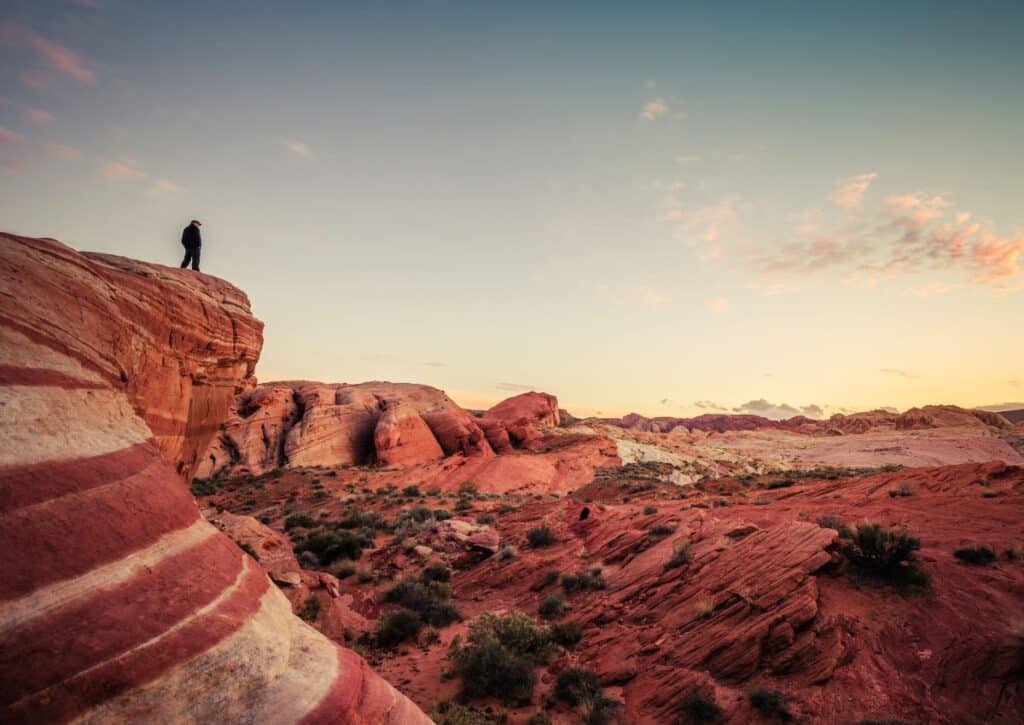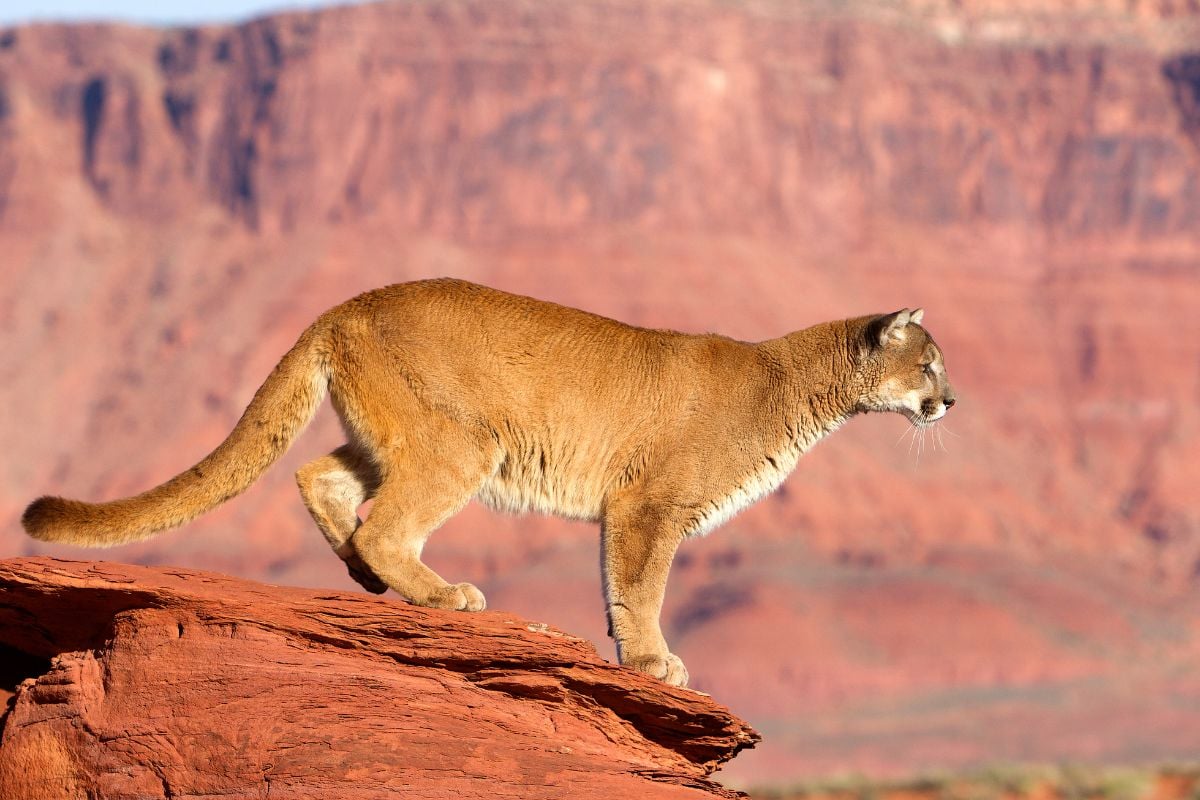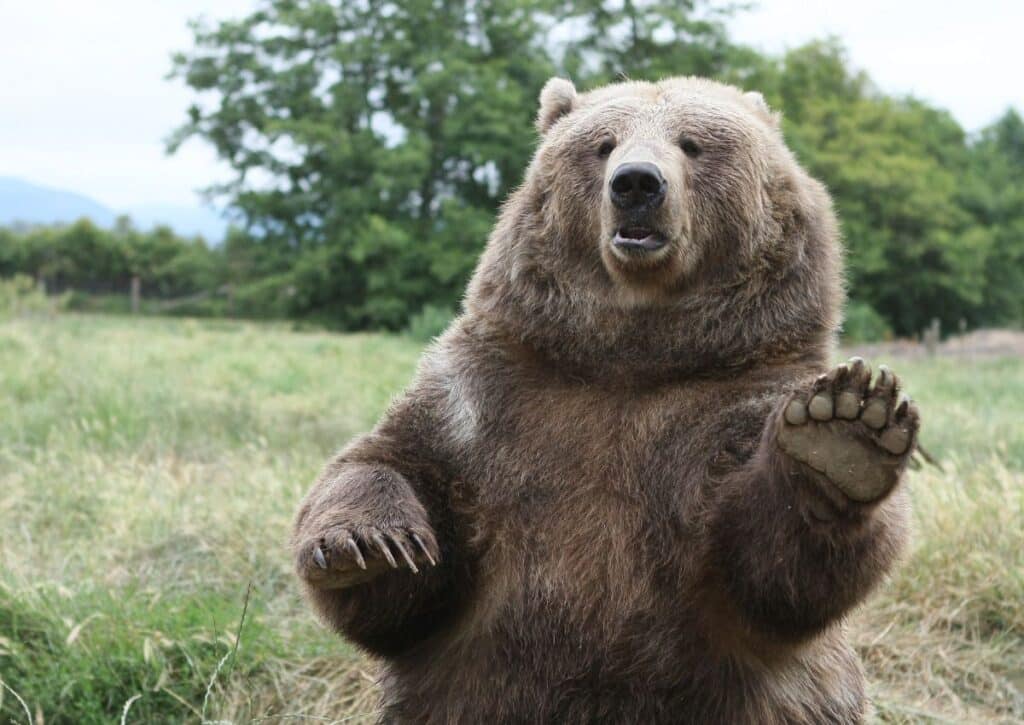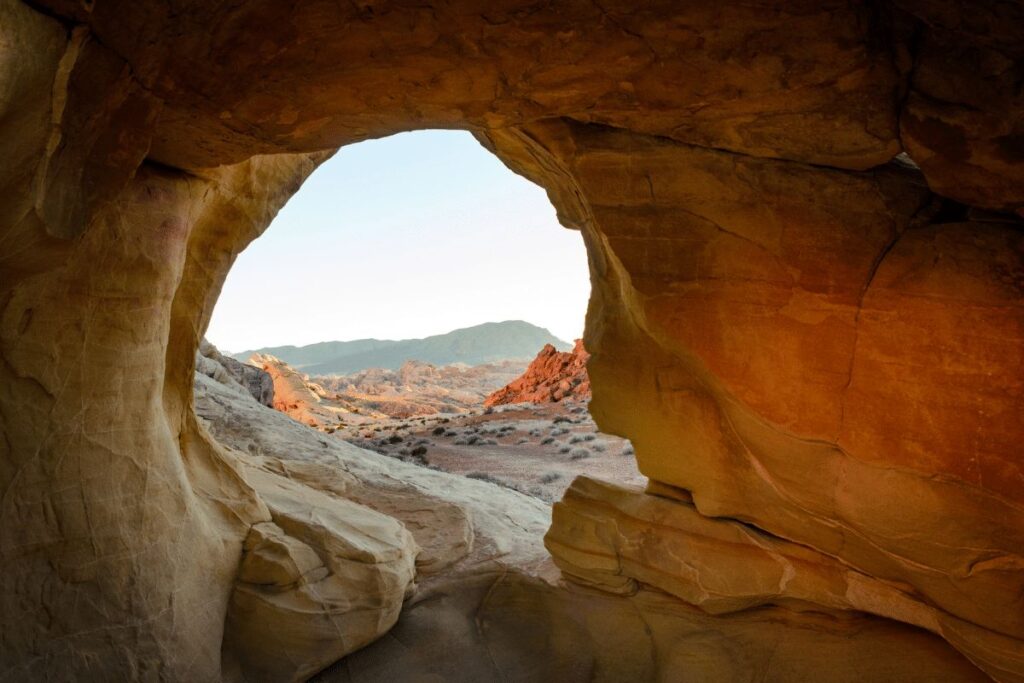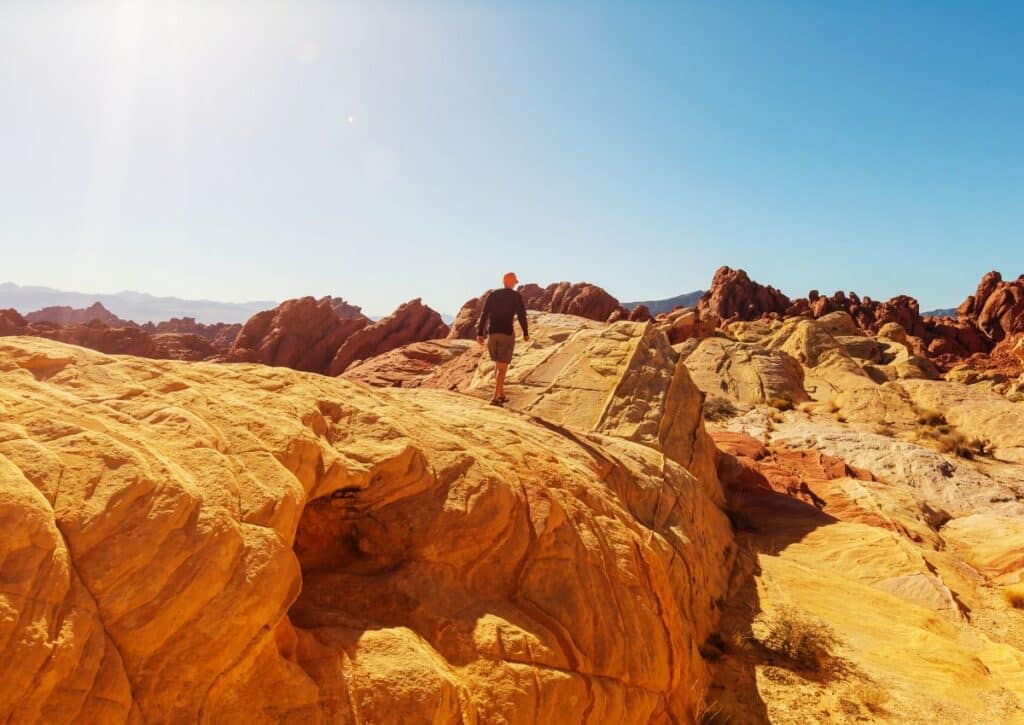Escape Vegas glitz for alien vistas behind Valley of Fire State Park’s rusty ridges. Our insider’s guide unpacks 15 phenomenal facts spanning surreal trails, bighorn sheep odysseys and 150-million-year-old art carved into Aztec Sandstone.
Just 50 miles from the Strip’s chaos lies this desert jewel tempting weekend warriors with oases of adventure. Where casinos cluster Vegas, quiet valleys whisper tales etched over lost eras.
Hack through crimson spires haloed in Hollywood blockbusters and catch the Fire Wave’s pastel undulations igniting at golden hour into artistry so surreal it hardly seems earthly.
Ponder 3,000-year old petroglyphs, delight in wildflowers carpeting the thirsty terrain and unlock geology secrets from lumbering elephants of eras past to the twisting legacy of tectonic upheaval.
From unexpected wildlife to unlikely floral abundance, Valley of Fire’s diverse splendor makes it an international outdoors paradise tempting road trippers to uncover its blazing beauty waiting in Nevada’s backyard!
Geological Wonderland
Venture into the Valley of Fire State Park and you’re stepping back in time—150 million years, to be exact. This geological wonderland is a gallery of fiery red sandstone formations, each a testament to the shifting dynamics of Earth’s tectonic artistry.
Known as Aztec Sandstone, these formations are predominantly comprised of oxidized iron minerals, which give the park its signature blaze of reds, oranges, and yellows that ignite under the Nevada sun.

Sculpted by relentless winds and floods over eons, the park’s landscape is a visual symphony of arches, towers, and labyrinthine canyons. Here, the Elephant Rock stands as a sentinel of stone, while the Beehives’ stratified layers tell tales of ancient dunes turned to solid rock.
It’s a place where every grain of sand whispers stories of the Jurassic era, making the Valley of Fire a must-see spectacle for geology aficionados and adventurers alike.
Ancient Origins
Step into the Valley of Fire State Park, and you’re walking on sacred ground that predates our calendar by millennia. With more than 3,000 petroglyphs scattered across its expanse, this park is not just a natural wonder but a cultural treasure trove.
These carvings, some over 2,000 years old, are silent narrators of an ancient world. The Ancestral Puebloans left behind a complex lexicon of symbols etched into the varnished sandstone—each line and curve a record of their cosmic understanding and earthly endeavors.
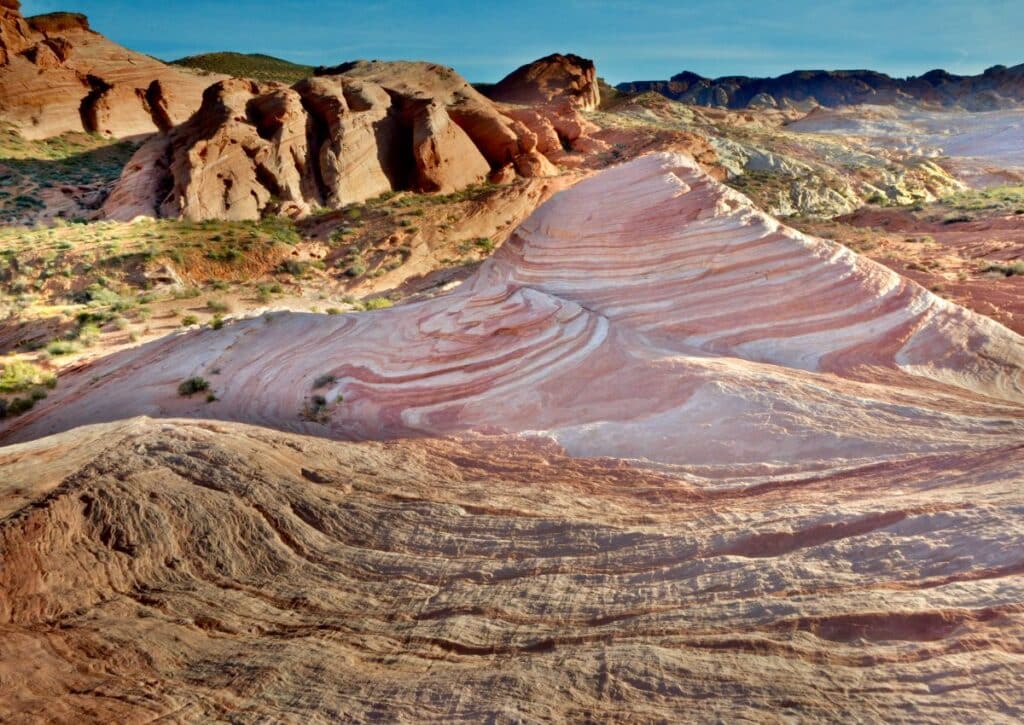
Among these, the bighorn sheep stand out, not merely as a subject of prehistoric art but as a crucial element of survival, hinting at the rich biodiversity that sustained ancient civilizations.
These petroglyphs aren’t mere art; they’re a dialogue across time, offering us a glimpse into the lives and minds of those who shaped the spear-throwing atlatl and thrived under the fiery Nevada skies.
Hollywood’s Backdrop
Valley of Fire State Park has long been a favored destination for filmmakers seeking otherworldly landscapes on Earth. Its striking red sandstone formations and panoramic vistas have featured prominently in a diverse array of films.
In “Total Recall,” the park’s Martian-like terrain convinced viewers they were glimpsing the Red Planet. “Star Trek Generations” harnessed the park’s alien beauty to craft an unforgettable setting for interstellar adventure.
Its versatility as a location is further showcased by its appearance in the high-octane chase scenes of “Transformers,” where the park’s natural grandeur was juxtaposed with futuristic action.
Beyond action and science fiction, the park provided a haunting backdrop for the apocalyptic narrative of “The Stand,” demonstrating its ability to adapt to any story.
With each film, Valley of Fire has not just been a set but a silent character, adding depth and drama to cinematic tales.
Diversity of Wildlife
Valley of Fire State Park is a thriving haven for a diverse range of wildlife, each species adapted to the Mojave Desert’s rugged environment. The park is home to the elusive desert bighorn sheep, Nevada’s state animal, which can be spotted gracefully navigating the rocky terrain.
Coyotes, the clever survivors of the desert, roam the landscape, while the black-tailed jackrabbit bounds through the underbrush, a common sight in the cooler hours.
The park’s skies are ruled by birds of prey, including the majestic golden eagle and the sharp-eyed red-tailed hawk, circling overhead in search of their next meal. Smaller avian species, like the vibrantly colored canyon wren and the clever raven, add melody and mischief to the park’s soundtrack.
Reptiles also find sanctuary in the Valley of Fire, with the desert tortoise—a species considered a keystone of desert ecology—living within the park’s protected bounds.
The chuckwalla, a hefty lizard, basks on sun-drenched rocks, while the more diminutive side-blotched lizard scuttles across the sand, a quick flash of movement to the observant eye.
This array of creatures, each playing its role in the desert’s ecological tapestry, makes the Valley of Fire a living laboratory for wildlife enthusiasts and a testament to nature’s adaptability.
Flora Amidst the Fire
In the Valley of Fire State Park, a botanical spectacle defies the harsh desert conditions. Here, a myriad of plant species flourishes amidst the arid landscape, painting the valley with life.
The creosote bush, one of the oldest living organisms on Earth, dots the terrain with its small yellow flowers, releasing a distinctive rain-like fragrance after rare showers. The fiery red sandstone provides a dramatic backdrop for the bright pops of color from blooming indigo bushes and desert marigolds.
The resilient Mojave yucca thrusts its spiky leaves towards the sky, while the Joshua tree, a hallmark of the Mojave, stands sentinel with its twisted, bristled limbs.
Springtime visitors are greeted by a carpet of wildflowers, including the delicate desert primrose and the fiery red Indian paintbrush, which seem to light the ground ablaze with their vibrant hues.
These plants are not just survivors; they are master adapters, employing deep roots and water-storing strategies to thrive in an environment where rainfall is a precious rarity.
Their presence is a triumph of life over adversity, making the Valley of Fire a botanical treasure trove waiting to be discovered.
A Photographer’s Paradise
The Valley of Fire State Park is a photographer’s dream, a landscape crafted by time into a canvas ripe for capturing. With every sunrise and sunset, the valley’s sandstone formations catch the light, transforming them into glowing sculptures that beg to be immortalized through the lens.
Photographers are drawn to the iconic “Fire Wave,” with its swirls of red and white stone that emulate ocean waves frozen in time.
The park’s vast vistas offer panoramic shots of a land seemingly untouched by modernity. At Elephant Rock, the natural archway provides a frame for the sky’s shifting palette, while the ancient petroglyphs of Atlatl Rock tell stories in silhouette against the stark desert sky.
The juxtaposition of vibrant wildflowers against the red earth during spring provides a contrast that is a delight for macro photography enthusiasts.
Night brings its own allure, as the park boasts one of the darkest skies in the region, making it a hotspot for astrophotography.
The Milky Way’s arc, stretching over the jagged horizon, creates a celestial spectacle above the fire-hued landscape. Every corner of the Valley of Fire is a testament to the beauty of the natural world and a magnet for shutterbugs worldwide.
The Fire Wave
The Fire Wave stands as Valley of Fire State Park’s crowning jewel, an exquisite blend of color and form that lures visitors into its embrace.
Here, the sandstone has been coaxed by wind and water over eons into sinuous layers, each band a different chapter in the valley’s vibrant geological history.
Visitors to the Fire Wave are treated to a spectacle of nature’s artistry, where the contours of red and white stone ebb and flow like the sea’s tides frozen in time.
This natural wonder is not tucked away in inaccessible mystery but rather a mere 0.75-mile trek from the nearest trailhead, making it an accessible treasure for those willing to venture into the heart of the park.
The popularity of the Fire Wave is a testament to its allure; it’s a photogenic masterpiece at any time of day, with the interplay of light and shadow casting an ever-changing tableau.
At sunrise and sunset, the formation ignites, glowing as if the rock itself were alight with inner fire, a phenomenon that has captured the imagination of countless photographers and nature lovers.
The Scenic Byway
Traversing the Valley of Fire State Park’s Scenic Byway is a journey through a corridor of geological and historical marvels. This 10.5-mile stretch, officially known as Mouse’s Tank Road, offers access to some of the park’s most spectacular landscapes.
Along the drive, travelers encounter over 40 million years of geological history, with rock formations spanning the Jurassic to the Cretaceous period.
About a mile in, the Rainbow Vista viewpoint unfolds, offering a 360-degree panorama where layers of red, pink, and white rocks paint a multicolored desert canvas. Further along, at mile 5.5, the road skirts past the Atlatl Rock, showcasing petroglyphs that are a testament to human history dating back thousands of years.
White Domes Road intersects at mile 9, leading to a loop that reveals a stunning contrast between ancient, bleached sandstone domes and the valley’s fiery backdrop.
For those seeking a glimpse of wildlife, the byway is also a corridor for desert fauna. It’s not uncommon to spot roadrunners darting across the road or hear the distant yips of coyotes as the dusk settles.
This drive isn’t just a route; it’s a narrative of Earth’s dynamic story, offering a new chapter around each bend for the intrepid traveler.
Hiking Trails Galore
Valley of Fire State Park is a hiker’s playground, boasting over 30 miles of trails, each offering a unique way to experience the park’s fiery landscapes. The trails range from easy 0.3-mile strolls to strenuous 7.5-mile treks, catering to adventurers of all levels.
One of the park’s most frequented trails is the Fire Wave Trail, a 1.5-mile round trip that leads hikers to the park’s signature swirling rock formations.
For those seeking a window into the past, the 0.8-mile Petroglyph Canyon Trail to Mouse’s Tank immerses travelers in ancient storytelling, as hundreds of petroglyphs dot the canyon walls.
The White Domes Trail, a moderate 1.1-mile loop, winds through stunning sandstone formations and past the remnants of an old movie set.
Another gem is the 7.5-mile Prospect Trail, offering a more challenging hike with rewarding vistas of both the fiery rocks and the distant, shimmering Lake Mead.
Each trail in the park promises its own rewards, from the short but sweet 0.3-mile boardwalk of the Fire Cave, rich with photo opportunities, to the immersive, 4-mile Rainbow Vista and Fire Canyon Lookout trek that offers expansive desert panoramas.
These paths are not just routes through the desert but invitations to explore and discover the natural wonders of the Valley of Fire.
Camping Under the Stars
Valley of Fire State Park elevates camping to an experience under a canopy of stars. With two campgrounds, Arch Rock and Atlatl Rock, featuring a combined total of 72 units, campers have the chance to settle in amidst the park’s stunning geology. Each site is equipped with shaded tables, grills, water, and restrooms with showers, ensuring comfort amidst the wild.
Arch Rock, the smaller of the two with 29 spots, offers a more intimate setting, often preferred by those seeking serenity. Atlatl Rock, larger with 43 sites, includes RV spaces with power hookups, catering to those looking for a home on wheels with a view. The cost is a modest $20 per night for standard sites, with an additional $10 for sites with power, making for an affordable escape into nature.
As dusk falls, the lack of light pollution allows the Milky Way to emerge in breathtaking clarity, a sight increasingly rare in today’s world.
Campers often find themselves gazing upward in awe, as constellations tell their ancient stories. Nighttime temperatures can drop, adding a crispness to the air that enhances the sense of adventure.
Climate Extremes
Valley of Fire State Park is an exhibition of climate extremes, where temperatures can soar to a scorching 120°F in the shade during the peak of summer, challenging even the hardiest of explorers. In the winter, the mercury can plummet to a crisp 30°F, a stark contrast to the heat that earns the park its name.
For those seeking the best time to traverse this fiery landscape, the fall months emerge as the ideal period. With daytime temperatures averaging a pleasant 75°F to 80°F, the park is transformed into a comfortable outdoor haven, allowing for extended hikes and exploration.
Evening temperatures hover around a comfortable 50°F, perfect for campfire chats and stargazing sessions.
The moderate fall climate also unveils the park’s subtler beauty—shifting light casts new dimensions on the sandstone, and cooler air carries the whispers of wildlife more prominently.
Visitors during this season witness a symphony of changing colors, not just in the skies but in the flora that dots the landscape.
The park’s climatic duality is a powerful reminder of nature’s forces, with fall offering a harmonious balance, making it the park’s showcase season for those seeking to immerse themselves in its natural wonders without the extreme heat.
Visitor Activities
Valley of Fire State Park is a playground of activities, extending far beyond the realms of hiking and camping. For the history buffs, there are guided tours that delve into the park’s storied past, including visits to ancient petroglyph sites, some dating back over 2,000 years.
Photography workshops are a popular draw, taking advantage of the park’s photogenic landscapes. These workshops cater to all skill levels, teaching visitors how to capture the fiery glow of the rocks and the subtle interplay of light and shadow.
For the more adventurous, rock climbing opportunities abound, with routes that cater to both novices and seasoned climbers. The park’s unique geology offers a variety of climbs, from bouldering to full-pitch ascents.
The visitor center, open year-round, provides a comprehensive educational experience with exhibits on the geology, ecology, and history of the park. It’s also the starting point for the Junior Ranger Program, a family favorite, which educates young visitors about the park through interactive activities.
Picnicking is another leisurely option, with designated areas set against the backdrop of the park’s stunning vistas. These spots provide grills and tables, making for an ideal break between adventures.
For those captivated by the celestial, the park’s dark skies make it a prime spot for stargazing, especially during meteor showers when the night sky becomes a theater of light.
Valley of Fire’s diverse offerings ensure that every visitor can find an activity that resonates, whether seeking education, adventure, or just a peaceful moment in nature’s embrace.
The Mystery of Atlatl Rock
Atlatl Rock, a captivating feature within Valley of Fire State Park, is steeped in ancient mystique. This massive sandstone formation is a gallery displaying some of the most intriguing petroglyphs in the park, believed to be over 4,000 years old.
The rock is named after the atlatl, a prehistoric hunting tool depicted in the carvings, showcasing the ingenuity of early Native American cultures.
Climbing the metal staircase attached to the rock’s side, visitors ascend towards a window into the past, where hundreds of petroglyphs offer a visual narrative of life in a bygone era.
The etchings include representations of animals, spirals, and geometric shapes, each a clue to the daily existence and spiritual practices of the ancient peoples who once thrived in this desert.
Atlatl Rock isn’t just a historical site; it’s an archeological cornerstone that provides invaluable insights into the region’s prehistoric inhabitants.
The rock’s popularity among travelers is not only due to its historical significance but also because of its accessibility, allowing visitors of all ages to come face to face with artifacts of human antiquity.
The mystery of Atlatl Rock lies not just in the petroglyphs’ meanings but also in their survival, enduring centuries of exposure to the elements, a testament to the resilience of the stories they tell.
Visitors leave with a sense of connection to the distant past and the enduring legacy of human expression.
An International Draw
Valley of Fire State Park is not just Nevada’s gem but a magnet for international visitors, drawing tens of thousands of globetrotters annually to its otherworldly terrain.
The park’s universal appeal lies in its unique combination of natural beauty, cultural history, and recreational variety, making it a bucket-list destination for travelers from every continent.
The spectrum of colors across the park’s landscapes captivates visitors from afar, with the Aztec Sandstone’s brilliant reds and golds offering a stark contrast to the blue skies.
The park’s accessibility is a boon, as it is located a mere 50 miles from the entertainment capital of the world, Las Vegas, making it an easy addition to travel itineraries.
Adventure-seekers from Europe, Asia, and beyond find solace in the park’s extensive network of trails, while history enthusiasts are drawn to the ancient petroglyphs that decorate its canyons, connecting visitors from modern metropolises to the primal artistry of ancient civilizations.
Photographers, amateur and professional alike, flock to the park to capture its panoramic vistas and geological formations, which are as photogenic as they are geologically significant.
The visitor center, with exhibits in multiple languages, caters to the international crowd, providing insights into the park’s 150 million-year-old history.
The Valley of Fire’s allure transcends borders, its fiery landscapes lighting up the imaginations of visitors from around the globe, and ensuring that its fame as a natural wonder continues to spread far and wide.
Easy Tours from Las Vagas
An escape to the Valley of Fire State Park is the perfect antidote to the Las Vegas Strip’s electric pulse. Situated a convenient 50 miles northeast of Vegas, this natural sanctuary can transform a weekend into an outdoor odyssey. It’s an accessible retreat where sin city’s slot machines give way to ancient slot canyons.
These top-rated tours, all personally vetted, promise to unveil the park’s rugged charm. They range from the adrenaline rush of a full-day ATV escapade to the tranquility of guided hikes through time-sculpted landscapes.
Each tour is designed to fit into a day trip, making the most of every hour with experiences like basking in the glow of a desert sunset that outshines even the brightest casino lights.
Whether it’s the intimacy of a private tour, the thrill of combining the fiery rocks with the pastel hues of the Seven Magic Mountains, or the historical allure of the Lost City Museum, there’s a journey for every taste.
For those with an appetite for adventure, the Valley of Fire is a mere hour’s drive from the buzz of Vegas, yet worlds apart. It’s an easy switch from the city’s nocturnal life to daylight wonders, where every trail and tour promises a vivid memory to take back to the neon city.
Conclusion
In wrapping up our Valley of Fire escapade, it’s clear that this natural wonder is an epic off-strip adventure that dazzles and delights.
Just a short drive from Las Vegas, it offers a stunning contrast to the city’s glitz with its rich tapestry of history, geology, and wilderness.
Whether scaling fiery rock formations, marveling at ancient art, or stargazing into the clear desert night, this park is a treasure trove of experiences.
So, as the Vegas lights fade in your rearview mirror, anticipate an adventure that’s as vibrant and enduring as the fiery landscape itself—a true highlight of the Mojave Desert.

